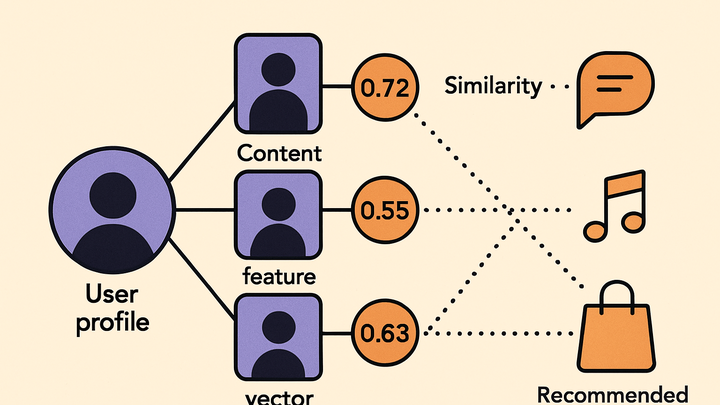Published on 2025-06-28T02:53:00Z
What is Content-Based Filtering? Examples for Analytics
Content-based filtering is a recommendation technique used in analytics to suggest items to users based on the attributes of those items and the user’s own preferences or past interactions. It builds user profiles by analyzing item features—such as keywords, categories, or metadata—associated with the content the user has engaged with. The system then compares these user profiles with the feature profiles of new items, using similarity metrics like cosine similarity or TF-IDF vectorization. Unlike collaborative filtering, which relies on patterns across multiple users, content-based filtering focuses solely on the content itself, making it effective for recommending niche or new items. This approach enables transparent, interpretable recommendations, since each suggestion is directly tied to identifiable item characteristics. However, it requires comprehensive and high-quality metadata to ensure accurate matching and can struggle with providing diverse or novel recommendations without additional diversification strategies.
Content-based filtering
A recommendation technique that suggests items by matching item attributes to user profiles via similarity metrics.
How Content-Based Filtering Works
Deep dive into the core algorithmic steps behind content-based filtering and how profiles are constructed.
-
User profile construction
Building a representation of user preferences based on past interactions and consumed content.
-
Interaction history
Collect data on items the user has viewed, clicked, liked, or purchased.
-
Feature extraction
Extract metadata such as keywords, categories, descriptions, and tags from each item.
-
-
Item profile representation
Characterizing each item by a vector of its content features.
-
Metadata tags
Use structured tags (e.g., genre, author, product category) to describe items.
-
Content features
Analyze unstructured data (e.g., text, images) and convert into feature vectors.
-
-
Similarity computation
Calculating how closely a user profile matches each item profile.
-
Cosine similarity
Measure the cosine of the angle between user and item feature vectors.
-
Tf-idf vectorization
Weight keywords by term frequency–inverse document frequency to emphasize distinctive terms.
-
Benefits and Limitations
Explore the strengths and potential drawbacks when applying content-based filtering in analytics.
-
Advantages
Offers personalized, transparent recommendations and handles new items without historical data.
-
Limitations
Can lead to overspecialization, requires rich metadata, and may miss serendipitous discoveries.
Implementation with SaaS Analytics Tools
Practical setup examples using PlainSignal (cookie-free analytics) and GA4 to support content-based filtering workflows.
-
PlainSignal (cookie-free analytics)
Configure PlainSignal to capture item attributes and user interactions, then export or process them for similarity scoring.
-
Tracking setup
Include the PlainSignal script on your site to collect user events and item metadata.
-
Code example
<link rel='preconnect' href='//eu.plainsignal.com/' crossorigin /> <script defer data-do='yourwebsitedomain.com' data-id='0GQV1xmtzQQ' data-api='//eu.plainsignal.com' src='//cdn.plainsignal.com/plainsignal-min.js'></script>
-
-
GA4 (google analytics 4)
Use GA4 to track item interactions along with custom dimensions, then export data to BigQuery for computing recommendations.
-
Custom dimensions
Define item attributes (e.g., category, tags) as custom dimensions in GA4 Admin.
-
Data export
Stream GA4 events to BigQuery and run SQL queries to compute similarity scores and generate recommendations.
-
Best Practices and Considerations
Recommendations to optimize accuracy, diversity, and scalability of your content-based filtering system.
-
Feature engineering
Ensure consistent, high-quality metadata and enrich item profiles with natural language processing where possible.
-
Diversity and novelty
Introduce re-ranking or serendipity techniques to prevent overspecialization and improve user discovery.
-
Performance optimization
Leverage vector databases or approximate nearest neighbor search (e.g., FAISS, Annoy) for real-time recommendation performance.
